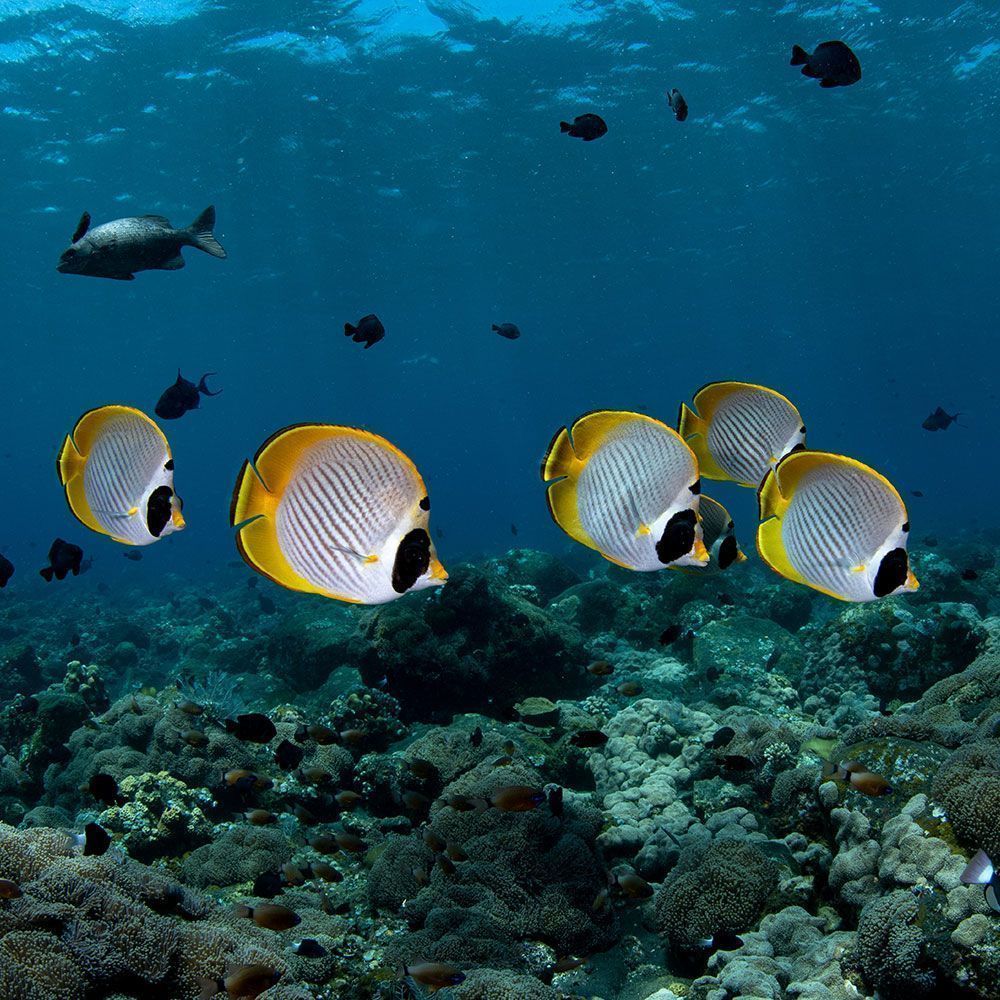Butterflyfish species are a group of fascinating tropical fish that add oomph to your marine tank!
Owing to their exquisite and beautiful colors, the head-turning species serve as great conversation starters. This makes the species one of the most desirable saltwater fish.
Especially if you have good fishkeeping skills and can afford a large setup, caring for these species is truly a rewarding experience.
Novice aquarium keepers should approach with caution, as these fish demand more care and attention than the average species.
Now, if you wish to know more, keep reading.
What are Butterflyfish?
Butterflyfish are colorful tropical marine fish found in small schools or solitary, with some being popular for bonding with a mate for a lifetime.
Belonging to the Perciformes order and Chaetodontidae family, there are 129 species from 12 genera, mostly in the Atlantic, Indian, and Pacific oceans. This group includes bannerfish and coralfish.
They have disk-shaped bodies and rounded tails similar to angelfish. Most of them have brighter colors on one side and the muted side helps them camouflage from danger. They can change colors based on their surroundings and brighten when aggressive.
Since they feed on coral polyps and small invertebrates by pecking at rocks with their long snouts, most of them are considered non-reef-safe. The diurnal species is active during the day and sleeps in crevices at night.
They use sounds to ward off members of the same species and communicate with their mates.
These are well-adapted to their habitats, but climate change is threatening coral reefs and could impact their survival.
They’re preyed upon by sharks and large fish, but their ability to hide in crevices provides protection.
Let us take a peek into a top 10 fishes of the butterflyfish species.
1. What is Copperband Butterflyfish (Chelmon rostratus)?
The copperband butterflyfish has a silvery-white body, a flat, circular body, and a long, pointed snout. It has orange to copper vertical bars on its body and distinctive black markings. It also has a false eyespot on its dorsal fin.
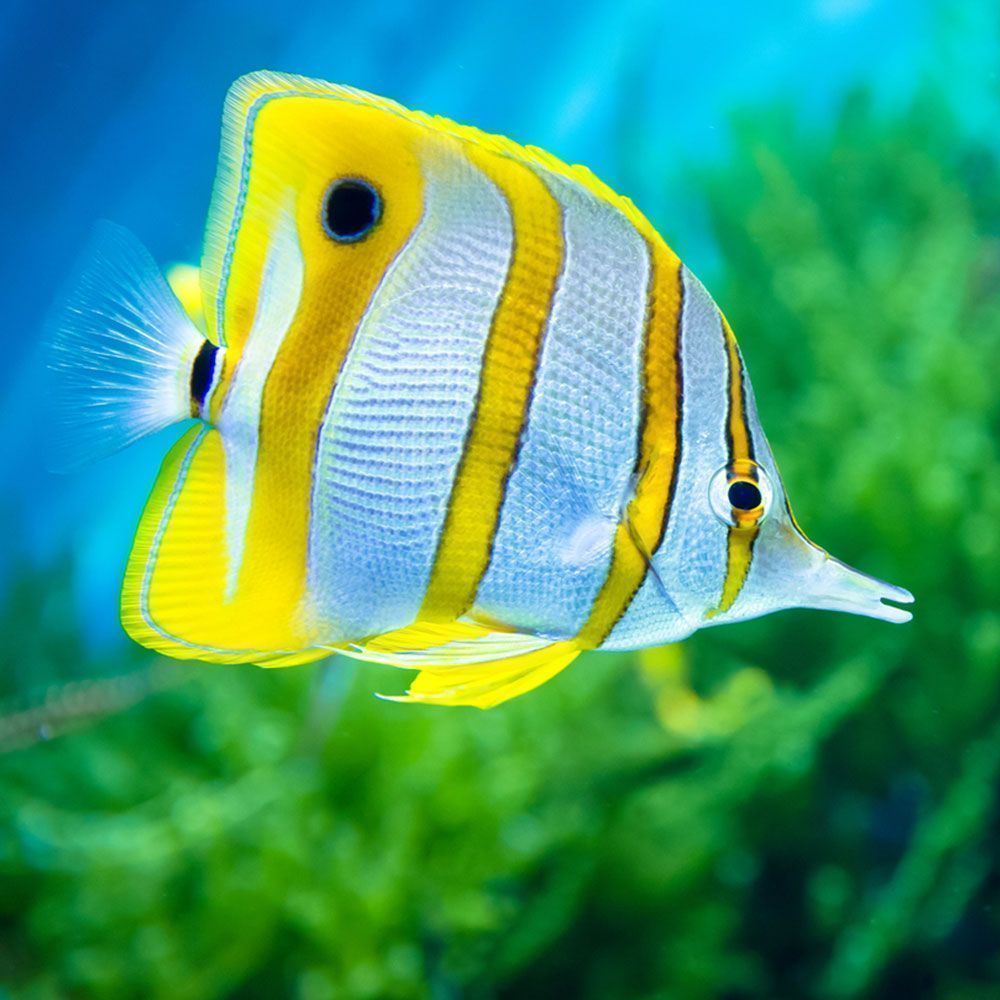
- Common Names: Beaked coral fish, longnose butterflyfish, beaked butterflyfish, banded long snout butterflyfish, orange stripe butterfly
- Average Size: Up to 20 cm (8 in)
- Average Lifespan: Average 8-10 years, Max: up to 15 years in captivity. Significantly shorter in the wild.
- Tank Level: All levels
- Temperament: Peaceful
- Diet: Carnivorous, feeds on benthic invertebrates, small crustaceans, and tubeworms.
- Reef Safe: Yes, with caution
- Tank Mates: Preferably alone, sometimes other peaceful species
- Minimum Tank Size: 125 gallons
It is a picky eater and can starve in captivity. It requires live foods like mysis shrimp, brine shrimp, and copepods, and can also eat frozen food soaked in garlic or vitamins. It may consume algae as well.
2. What is Longnose Butterflyfish (Forcipiger flavissimus)?
The longnose butterflyfish is a bright yellow fish with a sidewise-flattened body. Its head is black from the top of the mouth to the top of the head and the lower head is silvery white.
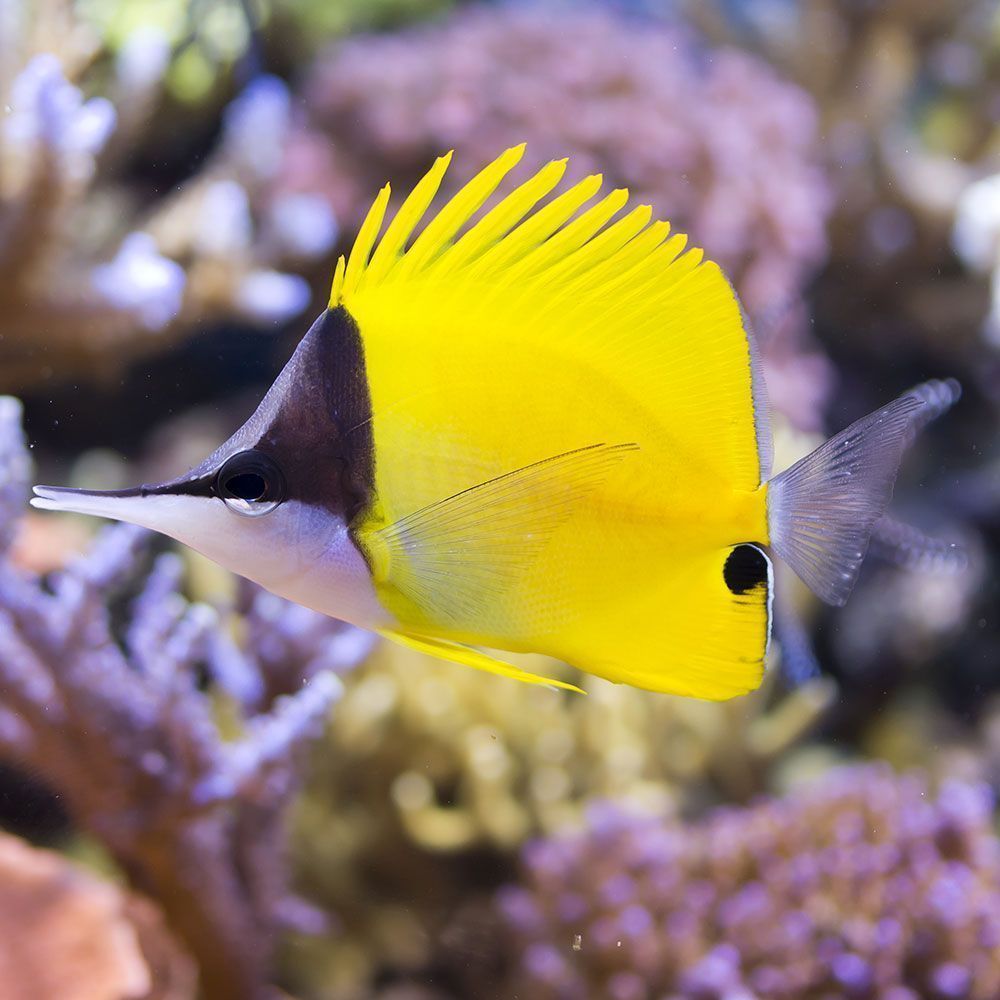
- Common Names: Yellow longnose butterflyfish, forceps butterflyfish, long-snouted butterflyfish, long-nosed coralfish, long-nosed butterflyfish, big long-nosed butterflyfish
- Average Size: Around 22 cm (8.6 in)
- Average Lifespan: 5 to 10 years in captivity, Max: 18 years
- Tank Level: All levels
- Temperament: Peaceful but territorial, aggressive toward own kind
- Diet: Carnivorous
- Reef Safe: Yes, with caution
- Tank Mates: Peaceful and semi-aggressive species that are sufficiently dissimilar in appearance
- Minimum Tank Size: 125 gallons
True to its name, it has a long, slender, pliers-like snout, used to pick food from crevices. Its pectoral and caudal fins are transparent, and it has jagged and long dorsal spines.
A black ocellus or eye spot appears on its anal fin.
It looks almost similar to its cousin, the big longnose butterflyfish (Forcipiger longirostris). Check for black dots on the chest (present in F. longirostris) and the extent of black coloration around the eye to differentiate between them. The black color covers the entire eye of F. longirostris but the lower part of F. flavissimus‘ eyes is silver.
3. What is Raccoon Butterflyfish (Chaetodon lunula)?
The raccoon butterflyfish has distinct large eyes and a masked face resembling the markings of raccoons.
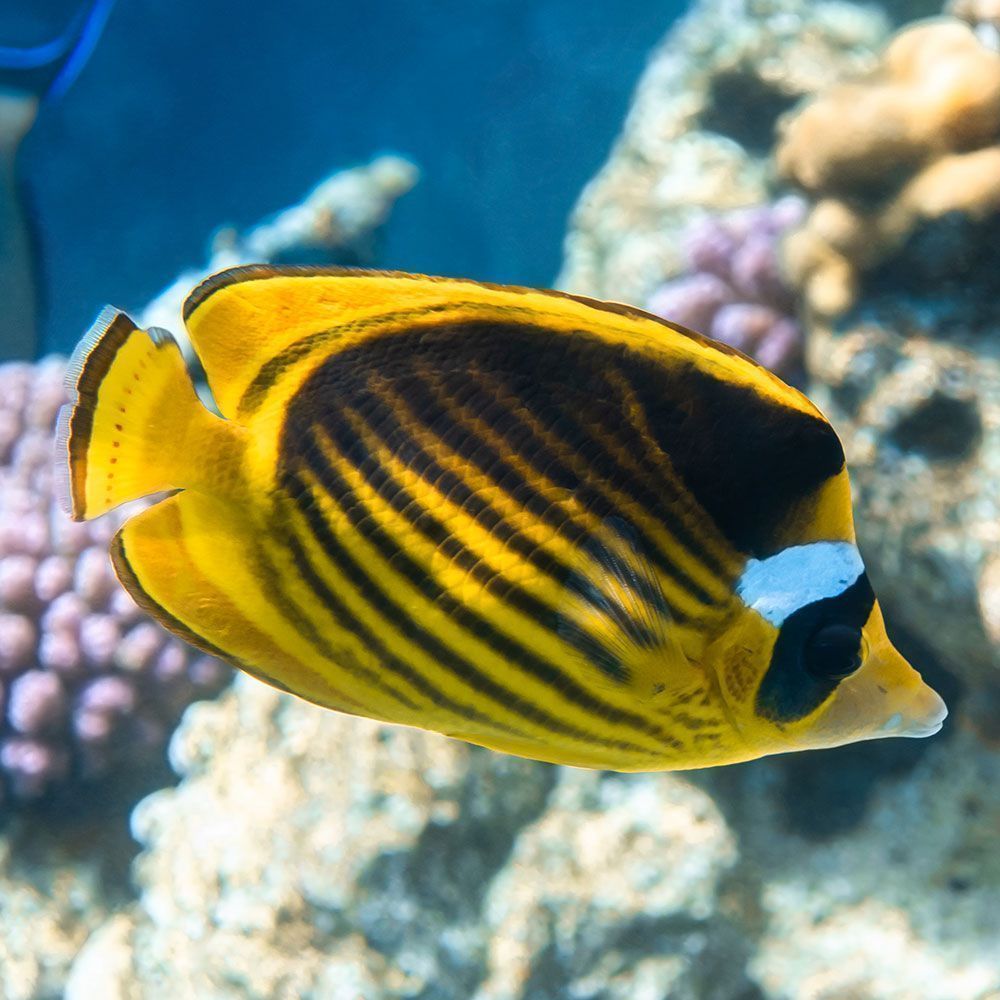
- Common Names: Spotted butterflyfish, red striped butterflyfish, racoon coralfish, raccoon butterflyfish, moon butterflyfish, halfmoon butterflyfish, lunula butterflyfish, crescent-masked butterflyfish
- Average Size: Upto 20 cm (8 in)
- Average Lifespan: 5-7 years in the wild, Up to 10 years in captivity
- Tank Level: All levels
- Temperament: Peaceful but territorial towards conspecifics and similar-looking fish
- Diet: Omnivorous
- Reef Safe: Yes, with caution
- Tank Mates: Similar-sized, non-aggressive fish
- Minimum Tank Size: 125 gallons
It’s brightly colored with a yellow-orange body, black, white, and yellow markings around the eyes, and a black spot near the tail.
Its body is compressed, oval-shaped with a continuous dorsal fin, truncated tail fin, short, protruding snout, and a small mouth.
Juveniles lack the middle black band and are less colorful than adults.
This species is a master of disguise! It adjusts its vibrant colors to match the surroundings, i.e., it fades at night to blend into coral reefs and brightens the body colors when angry.
4. What is Pearlscale Butterflyfish (Chaetodon xanthurus)?
The pearl scale butterflyfish has a pearly white body with black-edged scales, creating a cross-hatched pattern.
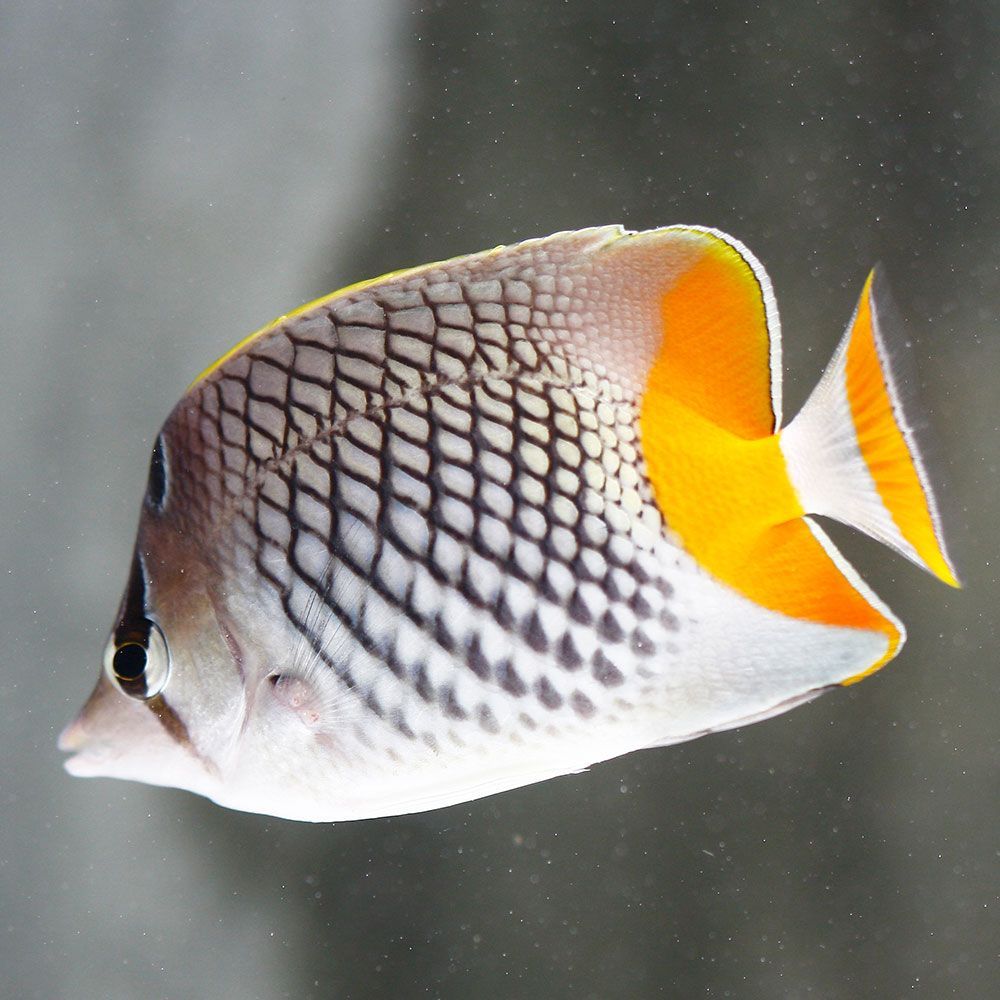
- Common Names: Yellow-tailed butterflyfish, crosshatch butterflyfish, Philippines chevron butterflyfish, netted butterflyfish, orange butterflyfish, black pearlscale butterfly, crowned pearl-scaled butterflyfish
- Average Size: Up to 15 cm (5.9 in)
- Average Lifespan: 5-7 years, can live more with best care
- Tank Level: All levels
- Temperament: Peaceful
- Diet: Omnivorous
- Reef Safe: Yes, with caution
- Tank Mates: Smaller, non-aggressive fishes, conspecifics
- Minimum Tank Size: 75 gallons
Its hind parts are orangey-yellow, the caudal fin base is white, and the head is darker than the body with vertical black eye stripes and a white-rimmed black crown spot.
Under aquarium light, its body appears iridescent. Orange and yellow accents adorn its dorsal and anal fins extending up to the peduncle and on the parts of the caudal fin in sickle-shaped bars. The tips of its dorsal fin are delicately outlined in yellow.
They are shy. To keep it stress-free, it needs plenty of live rocks and shelters to hide in. Providing these cozy spots helps it feel safe and secure!
5. What is Threadfin Butterflyfish (Chaetodon auriga)?
The threadfin butterflyfish has a white, broad, laterally compressed body with dark chevron-shaped markings. Its rear and caudal peduncle are yellow.

- Common Names: Yellow butterflyfish, whip butterflyfish, threadfin coralfish, threadfin, auriga butterflyfish, cross-stripe butterfly, threadfin butterfly
- Average Size: Up to 23 cm (9 in)
- Average Lifespan: Typically about 5 years, can live more with great care
- Tank Level: All levels
- Temperament: Peaceful
- Diet: Omnivorous with carnivorous tendencies
- Reef Safe: No
- Tank Mates: Peaceful and semi-aggressive fishes of similar size
- Minimum Tank Size: 150 gallons
It has a dark spot on its soft dorsal fin and a black bar across its eye from the top of the head to the jaw. It has an elongated snout and sharp teeth. It also features a belly patch with descending oblique dark lines.
There are two subspecies:
- Chaetodon auriga auriga: It’s found in the Red Sea and lacks the dorsal eyespot.
- Chaetodon auriga setifer: It’s a spotted population found outside the Red Sea.
The adult fish has a distinctive long filament extending from the dorsal fin that earns it its name.
The threadfin butterflyfish is closely related to other types of butterflyfish, like the vagabond and the Indian vagabond butterflyfish. They all have similar patterns on their bodies but differ in the colors at the back part of their bodies. Scientists also want to categorize them into a different type altogether.
6. What is Banded Butterflyfish (Chaetodon striatus)?
The banded butterflyfish has a deep, thin, flat, oval-shaped silvery body with vertical black bars. It is named after the bars, which help it hide from predators.
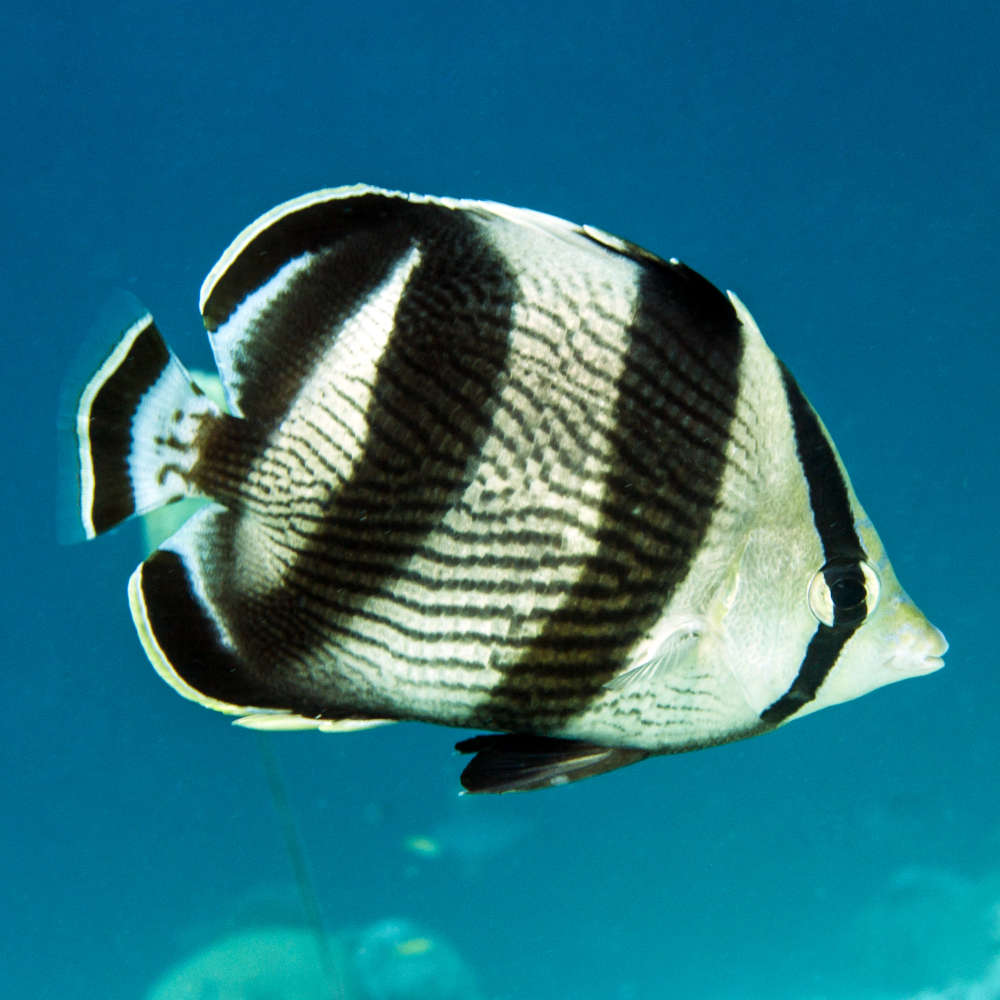
- Common Names: Banded butterflyfish, butterbun, Portuguese butterfly, school mistress, banded mariposa, Brazilian banded butterflyfish, striated butterflyfish
- Average Size: Up to 16 cm (6.5 in)
- Average Lifespan: Up to 5-7 years
- Tank Level: All levels
- Temperament: Peaceful
- Diet: Carnivorous
- Reef Safe: No
- Tank Mates: Smaller or similar, peaceful fish
- Minimum Tank Size: 125 gallons
One bar goes through its eye, two wide black bars in the middle, and a third wide bar that starts on the rear of the dorsal fin and continues to the caudal peduncle. The pelvic and caudal fins are black. It has a pointed snout and a concave forehead.
When young, it has a dark brownish-yellow colored body, four vertical body bars, and a large ringed black spot on the base of the dorsal fin to confuse predators. As it grows, the brownish-yellow area turns white.
At night, this fish seeks shelter to hide from predators like moray eels, sharks, and big reef fishes. If threatened during the day, it might try to escape. If it can’t, it stands its ground, facing the aggressor, making itself look spiky and intimidating, with erect dorsal fins like a tough bull ready to charge.
7. What is Four-eye Butterflyfish (Chaetodon capistratus)?
The four-eye butterflyfish is a sleek, deep, and laterally compressed fish. The light grey fish with iridescent stripes that have a vibrant yellow outline has dark, forward-pointing chevrons.
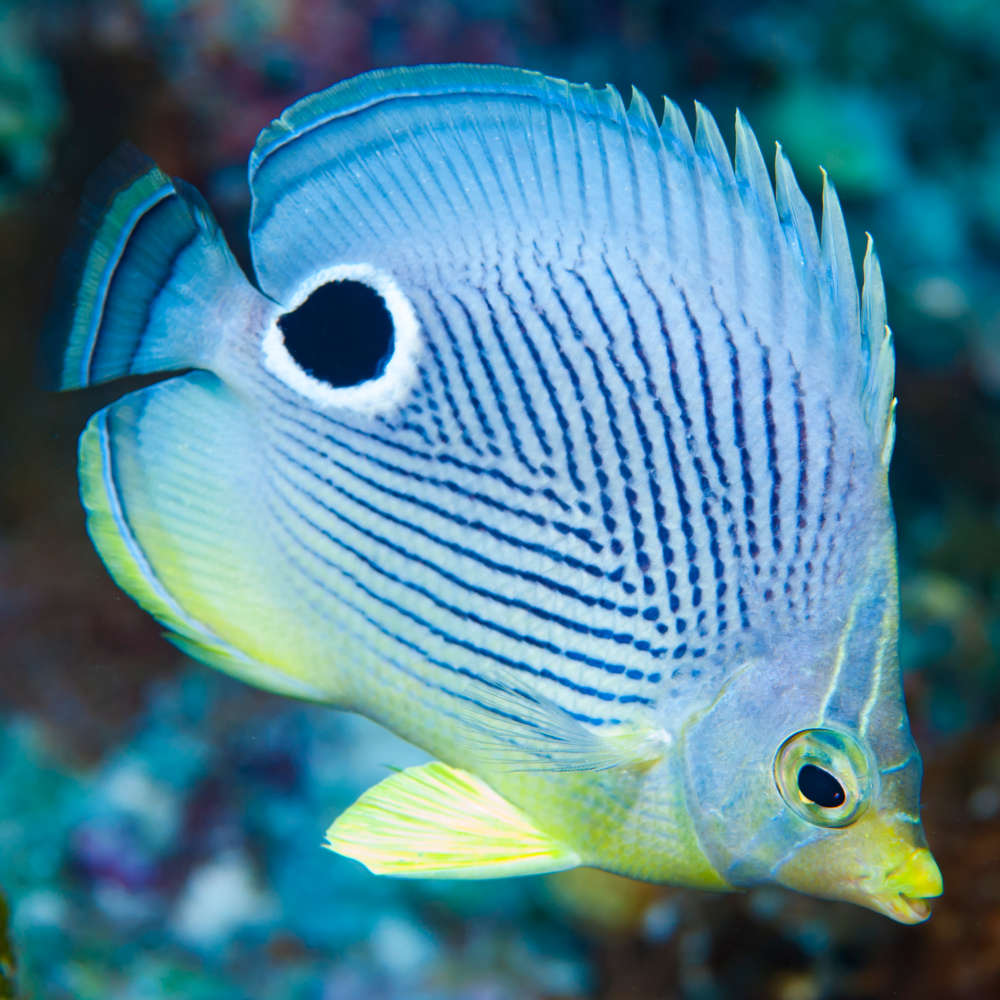
- Common Names: Four-eyed butterflyfish, butterfly, katy, kete, four spot butterflyfish
- Average Size: Up to 15 cm (6 in)
- Average Lifespan: Up to 7 years in the wild, 10 years or more in captivity
- Tank Level: Bottom and middle dweller
- Temperament: Peaceful
- Diet: Carnivorous
- Reef Safe: No
- Tank Mates: Peaceful non-butterflyfish species
- Minimum Tank Size: 125 gallons
It has two false eyespots near the base of its tail, surrounded by a white ring that looks like eyes.
This fish is really good at swimming around coral reefs. It can easily navigate through tight spaces by swimming on its side or even upside down. Its special skills help it move around comfortably in its underwater home!
8. What is Pyramid Butterflyfish (Hemitaurichthys polylepis)?
The pyramid butterflyfish has a geometric pattern of a large white triangle on the side of its body, bordered by yellow on the upper corners and a yellow anal fin.
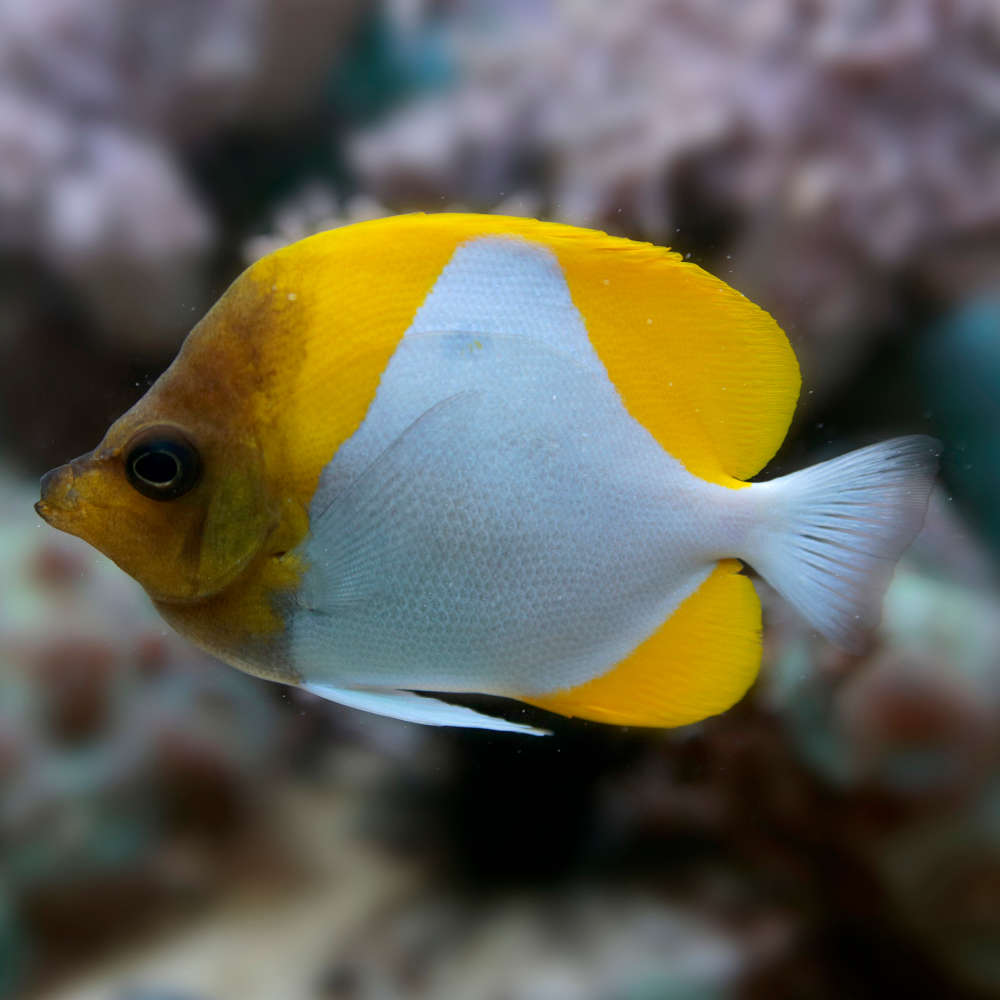
- Common Names: Shy butterflyfish, pyramid butterfly, brushy toothed butterflyfish, yellow zoster butterflyfish
- Average Size: Up to 18 cm (7 in)
- Average Lifespan: Up to 9 years
- Tank Level: Top to middle dweller
- Temperament: Peaceful
- Diet: Omnivorous
- Reef Safe: Yes
- Tank Mates: Similar-sized or slightly smaller, non-aggressive fish
- Minimum Tank Size: 125 gallons
The head is fully covered in a dark brown-yellow area that extends from the dorsal fin to the pelvic fins.
The pectoral, pelvic, and anal fins are white. Its body is laterally compressed with a rounded profile, and it has a slightly protruding snout with a small extendable mouth.
The unique fish has a special way of feeding! It uses its tiny, thread-like teeth called gill rakers inside gills to filter out plankton from the water. It expels the water out through the gills without swallowing it, showcasing a clever feeding technique.
9. What is Hawaiian Butterflyfish (Chaetodon tinkeri)?
The front half of this fish is pure white, with black dots on each scale. The rear (from the front of the dorsal fin to the back of the anal fin) of its body is deep black.
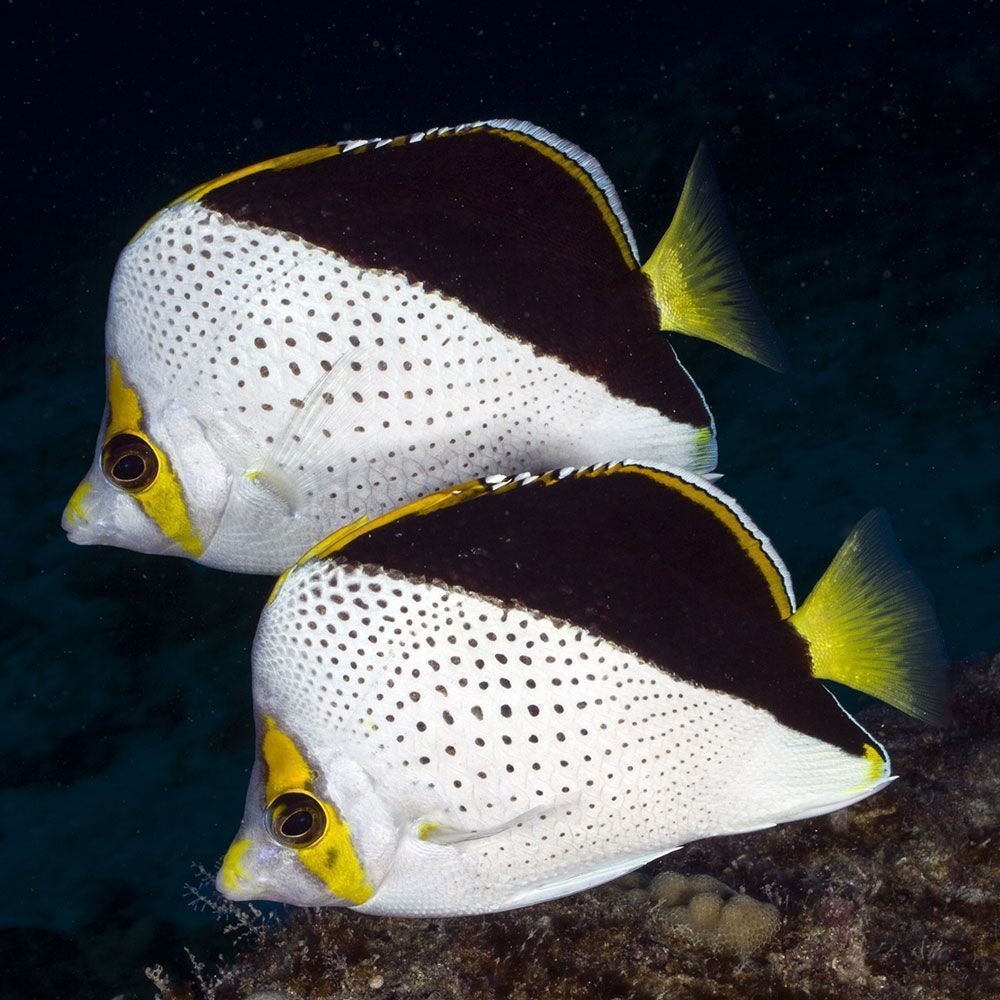
- Common Names: Tinker’s butterflyfish, tinker’s butterfly
- Average Size: Up to 15 cm (5.9 in)
- Average Lifespan: 5-12 years on average
- Tank Level: Bottom to middle dwellers
- Temperament: Peaceful
- Diet: Carnivorous
- Reef Safe: No
- Tank Mates: Own mate, peaceful and friendly species
- Minimum Tank Size: 125 gallons
Vibrant shades of yellow and orange highlight its face. The dorsal fin has a distinctive yellow and white rim, and the yellow caudal fin is transparent. It also has a yellow vertical bar over its eye, which can be slightly orangish in some individuals.
The Hawaiian butterflyfish shares its name with a notable figure – Spencer Tinker, the second Director of Waikīkī Aquarium- the second-oldest public aquarium in the United States.
10. What is Spotfin Butterflyfish (Chaetodon ocellatus)?
The spotfin butterflyfish earns its name from a distinctive dark spot on its dorsal fin. The fish has a black bar across its eye, a clever adaptation to confuse predators.
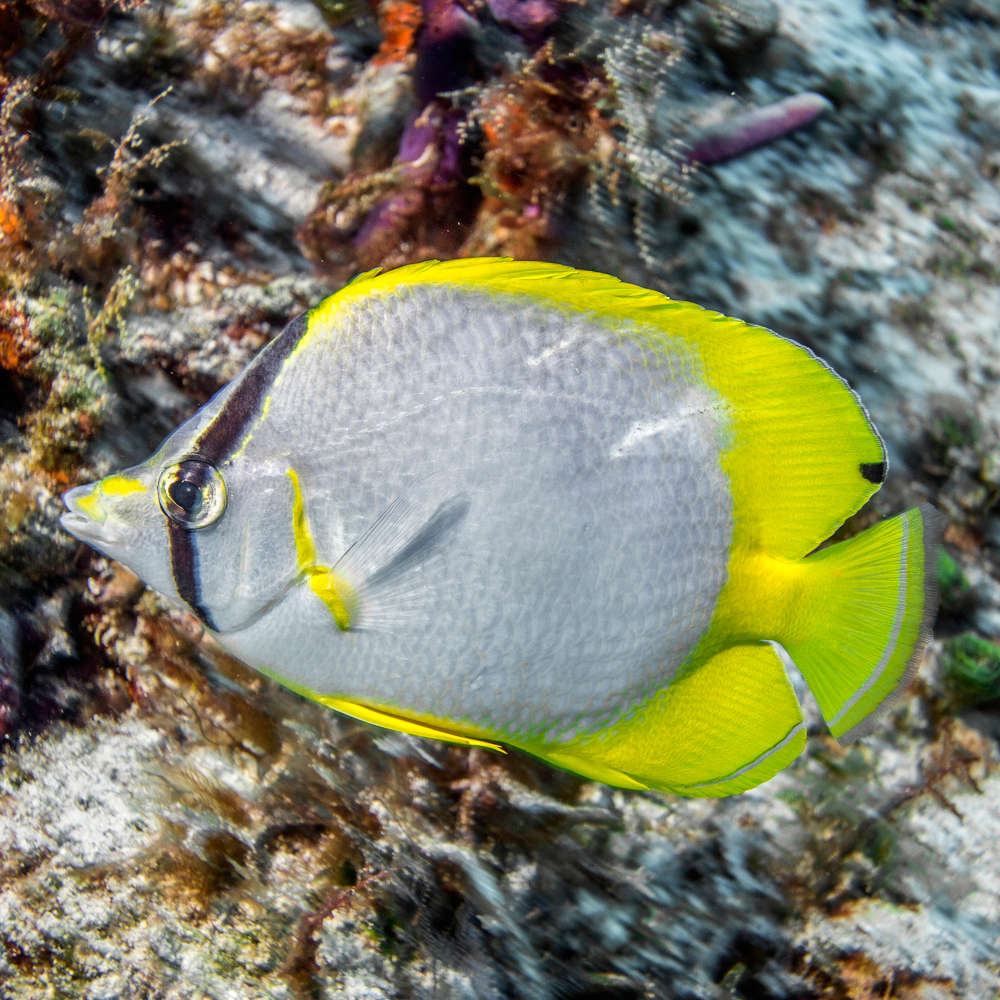
- Common Names: Two-spotted butterflyfish
- Average Size: Up to 20 cm (8 in)
- Tank Level: Bottom-middle dwellers
- Temperament: Peaceful but can get territorial
- Diet: Carnivorous
- Reef Safe: No
- Tank Mates: Peaceful species
- Minimum Tank Size: 125 gallons
Juvenile fish have another black bar across the dorsal fin base to the anal fin base. As it matures, this marking fades, but the other black bar becomes more prominent.
The fish has a nearly round, flattened body, white with a yellow posterior end and a pointed mouth. Most fins are yellow, except the pectoral fins.
What is the cost of Butterflyfish?
Butterflyfish are also available in a variety of prices – $50 to over $300. So, based on your budget and overall setup and monthly raising costs, you can easily grab yourself a charming aquatic friend!
A word from FishInAquarium
Butterflyfish don’t just have a captivating appearance with patterns. Their varying personality and antics draw many fish enthusiasts. Especially since they’re challenging to keep, expert and intermediate fishkeepers start the journey aiming to improve their skills even more!
If you found the article helpful, please share it with fellow enthusiasts. If you have additional inquiries or require further assistance, please don’t hesitate to contact us via email.
Happy Fishkeeping!

